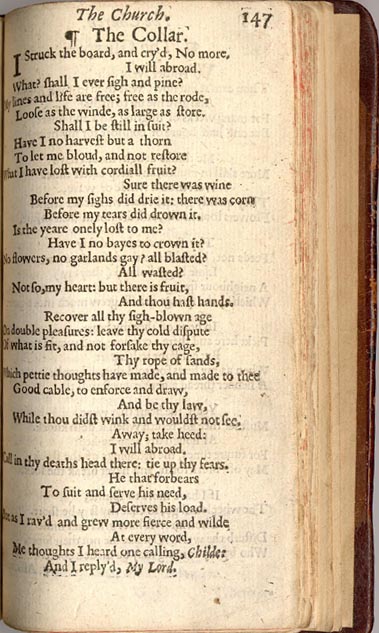
I Struck the board, and cry’d, No more.
I will abroad.
What? shall I ever sigh and pine?
My lines and life are free; free as the rode,
Loose as the winde, as large as store.
Shall I be still in suit?
Have I no harvest but a thorn
To let me bloud, and not restore
What I have lost with cordiall fruit?
Sure there was wine
Before my sighs did drie it: there was corn
Before my tears did drown it.
Is the yeare onely lost to me?
Have I no bayes to crown it?
No flowers, no garlands gay? all blasted?
All wasted?
Not so, my heart: but there is fruit,
And thou hast hands.
Recover all thy sigh-blown age
On double pleasures: leave thy cold dispute
Of what is fit, and not. Forsake thy cage,
Thy rope of sands,1
Which pettie thoughts have made, and made to thee
Good cable, to enforce and draw,
And be thy law,
While thou didst wink and wouldst not see.
Away; take heed:
I will abroad.
Call in thy deaths head there: tie up thy fears.
He that forbears
To suit and serve his need,
Deserves his load.
But as I rav’d and grew more fierce and wilde
At every word,
Me thoughts I heard one calling, Childe:
And I reply’d, My Lord.
|
|
1 Note on the "rope of sands" image: Teacher Mike writes "In Jorge Borges's story 'The Book of Sand,' he uses as an epigraph the words 'Thy rope of sands...' by George Herbert." By this point in the poem, the persona now sees everything that he has been taught and believed to be true is his "cage." He sees these truths, that he has been taught to accept as real, as the "rope of sands," ineffective, unreal. Until now, he believed and acted on them as if they were true. Now he rejects them as just "thy [talking to himself] rope of sands." The last 2 lines always remind me of the leash on the collar. I once watched a dog on a leash that someone had attached to a clothes line. The dog could cover the entire yard freely except for one end when the leash jerked him back and reminded him of his limits. The persona learns in the last 2 lines that the rope is not made of sand as he thought. JRA [Return] {Note to those who only know laundramats: A clothes line is a rope between 2 poles about 5 feet off the ground used for clothes hung on it to dry.}
General Note: The collar represents all externally enforced and internally reinforced restrictions on freedom. Irrelevant Note: There is a story of an African who had to wear an iron collar because he was a slave. When he was freed, he took off the collar. When he became a Christian, he willingly put the metal, slave collar back on. (Different Master.) Perhaps not irrelevant note: George Herbert, whenever he used the name of Jesus Christ, always added "My Master." See I Corinthians 7:21ff. [the Greek word may be translated "servant" or "slave."] [3 asides:
Explication/Interpretation/Criticism: Essay on Rhyme: Rhyme as a Poetic Image in The Temple by J. R. Arner. |
Internal and Internet Links to George Herbert’s Reputation and Influence.
Music Interpretation: A penillion arrangement of "The Collar," by Red Dragon.
To open music in another window.